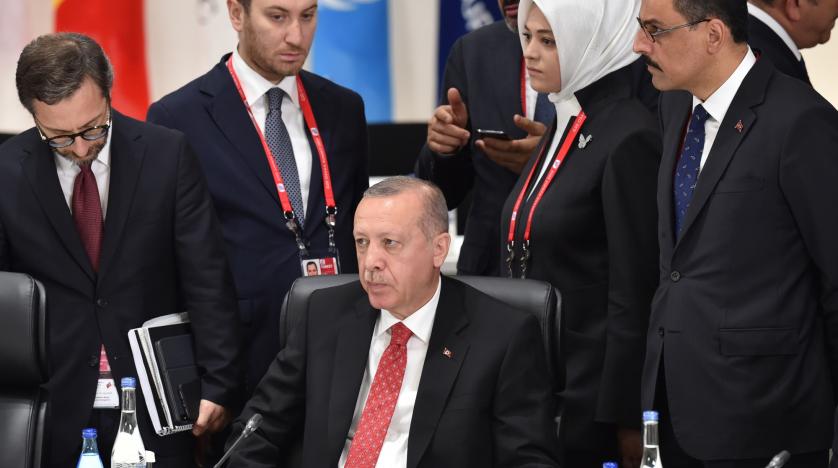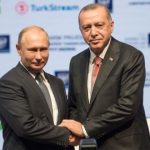Turkish President Recep Tayyip Erdogan, center, attends a session at the G-20 summit in Osaka. Kazuhiro Nogi/AFP
He told a gathering of his Justice and Development Party (AKP) in Ankara on Friday that the alleged plot’s aim is to raise interest rates and paralyze the Turkish economy’s growth.
Turkey’s central bank surprised markets on Thursday by cutting its main interest rate by 4.25 percentage points, less than a month after its governor was sacked.
The bank said the one-week repo rate was lowered to 19.75 percent from 24 percent, a bigger cut than the two or three percentage points the markets had been expecting.
Governor Murat Cetinkaya was fired on July 6, having reportedly clashed with Erdogan who opposes high interest rates, and replaced with his deputy, Murat Uysal.
In his statement to members of his ruling party, Erdogan hailed the central bank’s decision, calling for lowering interests to acceptable rates.
On Thursday, Turkey’s new central banker delivered the biggest interest-rate cut in at least 17 years, putting Erdogan’s unconventional policy goals into practice less than three weeks after getting the job.
It was the first cut since 2016 and the biggest since a shift to inflation targeting in 2002, Bloomberg reported.
“They’re rolling the dice,” said Paul McNamara, a London-based money manager at GAM UK, who helps oversee $9.4 billion in assets. “A very, very risky strategy. The worst-case scenario.”
The lira plunged just over 1 percent against the dollar after the decision before erasing losses. It traded 0.7 percent stronger.
The sharp pivot toward monetary easing runs the risk of spooking inflation-wary investors in pursuit of Erdogan’s unorthodox theory that high interest rates cause rather than curb price growth, Bloomberg said.
“The much bigger than anticipated cut marks the new era for a central bank whose independence has been severely undermined,” said Piotr Matys, a London-based strategist at Rabobank.
“While the lira has quickly recovered from the initial knee-jerk reaction,” the central bank’s decision “is a very clear signal that the interest-rate differentials will narrow markedly in the coming months, leaving the currency far more exposed when the external backdrop deteriorates,” Matys said.
“The central bank is walking a tightrope between an interventionist president who wants lower rates and financial markets likely to penalize excessive easing. Easier global monetary policy will encourage the bank to continue cutting until markets turn against the currency,” Ziad Daoud, a Mideast economist, said.
Uysal had plenty of reasons to start an easing cycle this month. The economy continues a slow slog after recession and lending is on the decline again. A dovish turn in monetary policy globally and a downswing in price growth have left Turkey with the world’s highest real rate before the decision.
According to Bloomberg, powerful base effects will likely continue to choke off inflation, which is already down almost 5 percentage points so far this year. The central bank on Thursday said recent forecast revisions indicate that inflation will probably end the year below the 14.6 percent projected in its April report.
In an interview last week, Uysal saw “room for maneuver in monetary policy” but vowed to preserve “a reasonable rate of real return” for investors.
If inflation falls to about 10 percent by September or October, “cuts will likely continue unless there is a negative development in the global outlook,” said Erkin Isik, senior economist at QNB Finansbank. Price growth cooled more than forecast in June to the slowest in a year, reaching an annual 15.7 percent.
“It seems like the central bank decided to deliver a front-loaded rate cut,” Isik said.



